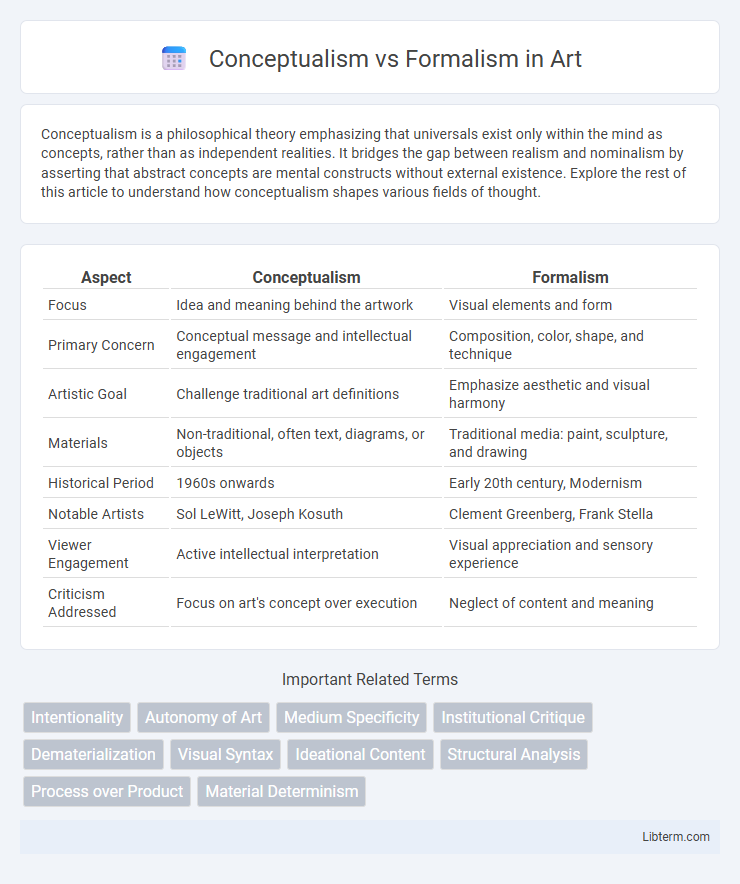Conceptualism is a philosophical theory emphasizing that universals exist only within the mind as concepts, rather than as independent realities. It bridges the gap between realism and nominalism by asserting that abstract concepts are mental constructs without external existence. Explore the rest of this article to understand how conceptualism shapes various fields of thought.
Table of Comparison
| Aspect | Conceptualism | Formalism |
|---|---|---|
| Focus | Idea and meaning behind the artwork | Visual elements and form |
| Primary Concern | Conceptual message and intellectual engagement | Composition, color, shape, and technique |
| Artistic Goal | Challenge traditional art definitions | Emphasize aesthetic and visual harmony |
| Materials | Non-traditional, often text, diagrams, or objects | Traditional media: paint, sculpture, and drawing |
| Historical Period | 1960s onwards | Early 20th century, Modernism |
| Notable Artists | Sol LeWitt, Joseph Kosuth | Clement Greenberg, Frank Stella |
| Viewer Engagement | Active intellectual interpretation | Visual appreciation and sensory experience |
| Criticism Addressed | Focus on art's concept over execution | Neglect of content and meaning |
Introduction to Conceptualism and Formalism
Conceptualism emphasizes the primacy of ideas and concepts over aesthetic or material aspects in art and philosophy, prioritizing mental constructs as the core of understanding. Formalism concentrates on the structural elements and formal qualities such as shape, color, line, and composition, treating these components as essential to interpreting a work's meaning. The contrast highlights Conceptualism's focus on intellectual engagement versus Formalism's attention to sensory and visual analysis.
Historical Origins of Each Movement
Conceptualism emerged in the 1960s as a reaction against traditional aesthetic values, emphasizing the primacy of ideas and the intellectual engagement over visual form, with roots tied to movements like Dada and Surrealism that challenged conventional art. Formalism traces its origins to early 20th-century modernist theories, particularly the writings of critic Clement Greenberg, who advocated for art's focus on medium-specific techniques and visual elements such as color, shape, and composition. These historical foundations highlight Conceptualism's prioritization of meaning and Formalism's dedication to pure visual form within the evolution of modern art.
Core Principles of Conceptualism
Conceptualism emphasizes that universals exist only within the mind as concepts rather than as independent realities, bridging the gap between nominalism and realism. It asserts that knowledge is based on mental abstractions formed through perception and cognition rather than external formal structures. Core principles include the belief that concepts are fundamental to understanding meaning, and that universal ideas are dependent on human thought processes rather than existing independently in the external world.
Defining Features of Formalism
Formalism in art emphasizes the importance of compositional elements such as color, line, shape, and texture over narrative content or emotional expression. It prioritizes the structural design and visual form, asserting that the artwork's value lies in its aesthetic qualities rather than external context or symbolism. This approach fosters objective analysis by isolating formal elements to understand an artwork's intrinsic artistic merit.
Key Artists and Influencers
Conceptualism champions ideas and processes over aesthetic form, with key artists like Sol LeWitt and Joseph Kosuth pioneering this movement by emphasizing language and instructions as art. Formalism centers on the visual elements and composition, led by critics like Clement Greenberg and artists such as Frank Stella, who focus strictly on shape, color, and materials. Both movements shaped contemporary art discourse, challenging traditional boundaries and highlighting different priorities in artistic expression.
Differences in Artistic Intent
Conceptualism emphasizes the idea or concept behind the artwork as the primary driver of meaning, often challenging traditional aesthetics and materials. Formalism prioritizes the visual elements such as color, composition, and technique, focusing on the sensory experience rather than the underlying message. The fundamental difference in artistic intent lies in Conceptualism's focus on intellectual engagement versus Formalism's dedication to formal qualities and visual harmony.
Impact on Art Criticism and Interpretation
Conceptualism challenges traditional aesthetics by prioritizing ideas over visual form, prompting art critics to reconsider the role of intellectual engagement in interpretation. Formalism emphasizes visual elements such as color, shape, and composition, guiding critics to focus on the artwork's sensory experience and structural aspects. This dichotomy impacts art criticism by shaping divergent approaches: Conceptualism encourages contextual and philosophical analysis, while Formalism advocates for an appreciation rooted in the formal qualities of the artwork itself.
Influence on Contemporary Art Practices
Conceptualism shifted contemporary art practices by prioritizing ideas and intellectual engagement over aesthetic form, encouraging artists to explore language, documentation, and ephemeral mediums. Formalism, emphasizing visual elements such as color, shape, and composition, influenced artists to focus on the purity of form and materiality, reinforcing modernist principles in abstraction and minimalism. The interplay between Conceptualism and Formalism continues to shape contemporary art, fostering diverse approaches that balance meaning and visual experience.
Common Misconceptions
Common misconceptions about Conceptualism and Formalism often stem from oversimplifying their distinctions; Conceptualism is mistakenly viewed solely as abstract idea-based art, while Formalism is reduced to mere aesthetic form without intellectual content. Critics frequently overlook that Conceptualism engages with the underlying meaning and context beyond visual elements, whereas Formalism emphasizes the intrinsic properties of art materials and compositional structure. Understanding the nuanced interplay between idea and form reveals that both movements contribute uniquely to art theory and practice, challenging reductive interpretations.
Conclusion: Bridging the Divide
Conceptualism and formalism represent contrasting yet complementary approaches to understanding meaning and structure in philosophy and art. Bridging the divide involves recognizing the interplay between underlying concepts and formal elements, allowing for a more holistic analysis that transcends strict categorization. This synthesis enriches interpretation by integrating conceptual insights with formal precision, fostering a comprehensive framework for critical evaluation.
Conceptualism Infographic

 libterm.com
libterm.com